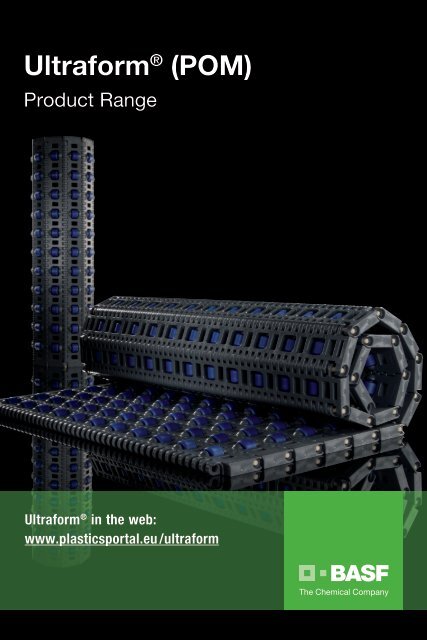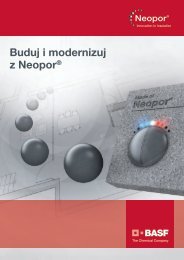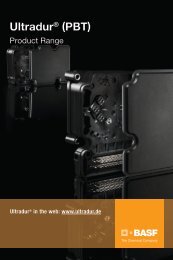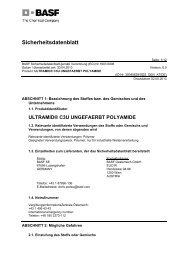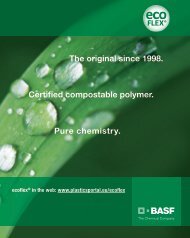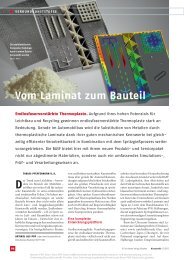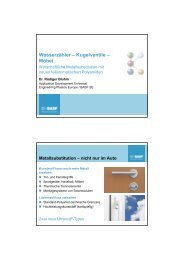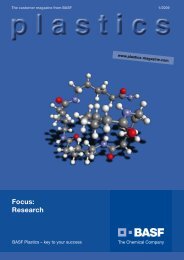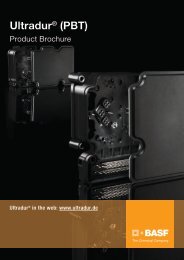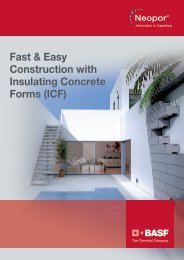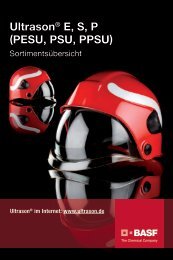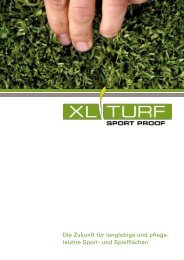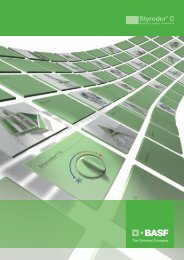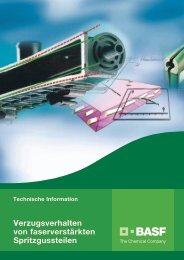Ultraform range chart - BASF Plastics Portal
Ultraform range chart - BASF Plastics Portal
Ultraform range chart - BASF Plastics Portal
You also want an ePaper? Increase the reach of your titles
YUMPU automatically turns print PDFs into web optimized ePapers that Google loves.
<strong>Ultraform</strong> ® (POM)<br />
Product Range<br />
<strong>Ultraform</strong> ® in the web:<br />
www.plasticsportal.eu /ultraform
<strong>Ultraform</strong> ® (POM)<br />
is the trade name for <strong>BASF</strong>’s product line of thermoplastically<br />
processable copolymeric polyoxymethylenes.<br />
The <strong>Ultraform</strong> ® family encompasses<br />
engineering plastics with different characteristics<br />
suitable for use in complex and highly durable<br />
components. <strong>Ultraform</strong> ® meets the requirements<br />
made of a technical material especially well. It<br />
combines high stiffness and strength with outstanding<br />
resilience, favorable sliding friction behavior<br />
and excellent dimensional stability, even<br />
under the effect of mechanical forces, in contact<br />
with numerous chemicals, fuels and other media<br />
as well as at elevated temperatures.
<strong>Ultraform</strong> ® (POM)<br />
Overview ProduCt portfolio 04<br />
<strong>Ultraform</strong> ® Grades<br />
Unreinforced grades<br />
Reinforced grades<br />
Impact-modified grades<br />
Grades with specific additives<br />
Emission-optimized grades<br />
Grades for medical applications<br />
Grades for drinking water applications<br />
06<br />
06<br />
10<br />
12<br />
16<br />
18<br />
20<br />
22<br />
Nomenclature 24
4<br />
Overview Product portfolio<br />
Overview Product Portfolio<br />
Unreinforced grades<br />
E3320<br />
H4320<br />
H2320 004<br />
H2320 006<br />
N2320 003<br />
N2320 0035<br />
S1320 003<br />
S2320 003<br />
S2320 0035<br />
W2320 003<br />
W2320 0035<br />
Z2320 003<br />
Z2320 0035<br />
High-molecular grade for extrusion blow molding of hollow parts.<br />
High-molecular-weight grade for extrusion of semifinished product; particularly thick-walled products<br />
can be extruded at high output rates; high thermal stability and low discoloration.<br />
High-molecular-weight grade for extrusion of small thin-walled pipes and panels.<br />
High-molecular-weight grade with somewhat increased flowability for injection molding of<br />
relatively thick-walled moldings.<br />
Rapidly solidifying standard grade for injection molding.<br />
Rapidly solidifying standard grade with improved impact strength for injection molding.<br />
Free-flowing, rapidly solidifying grade for moldings difficult to produce by injection molding<br />
and having low wall thicknesses, higher stiffness and thermal stability.<br />
Free-flowing, rapidly solidifying grade for moldings difficult to produce by injection molding<br />
and having low wall thicknesses.<br />
Free-flowing and rapidly solidifying standard grade with improved impact strength for injection molding.<br />
Very free-flowing, rapidly solidifying grade for use where processing is demanding but<br />
mechanical requirements are lower.<br />
Very free-flowing and rapidly solidifying grade for high processing demands.<br />
Rapidly solidifying grade for applications where processing is extremely difficult.<br />
Rapidly solidifying grade for applications with exceptional demands on flowability.<br />
Reinforced grades<br />
N2200 G43<br />
N2200 G53<br />
N2720 M210<br />
N2720 M63<br />
Injection-molding grade for parts requiring high stiffness and strength together with good mold release.<br />
Product with increased stiffness and strength as well as good wear characteristics, used, for<br />
instance, for sliding chains and conveyor systems.<br />
Mineral-reinforced material for low-warpage moldings with high stiffness, strength and hardness.<br />
Impact-modified grades<br />
N2640 Z2<br />
N2640 Z4<br />
N2650 Z2 LEV<br />
N2650 Z4 LEV<br />
N2640 Z6<br />
N2650 Z6 LEV<br />
N2644 Z9 R01<br />
N2640 E2<br />
N2640 E4<br />
Elastomer-modified injection-molding grades with high impact strength for clips, snap and fastening<br />
elements, also for components subject to impact stress.<br />
Elastomer-modified injection-molding grades with high impact strength and reduced emission<br />
potential for clips, snap and fastening elements, also for components subject to impact stress.<br />
Elastomer-modified injection-molding grade for applications requiring the highest impact strength<br />
together with low stiffness.<br />
Elastomer-modified injection-molding grade for applications with the highest demands on emissions<br />
and toughness at low stiffness.<br />
Elastomer-modified injection-molding grade for applications with a low modulus of elasticity.<br />
Good acoustic insulation.<br />
Elastomer-modified injection-molding grade with enhanced toughness and high weld line strength.<br />
Elastomer-modified injection-molding grade with high toughness and high weld line strength.
Overview Product portfolio<br />
5<br />
Grades with specific additives<br />
N2310 P<br />
N2770 K<br />
N2320 U035<br />
N2520 L<br />
N2320 C<br />
S1320 0021<br />
Standard injection-molding grade with special lubricant. Extremely low coefficient of friction<br />
and extremely low wear sliding friction, with smooth metal surfaces (low roughness).<br />
Injection-molding grade with improved wear characteristics for sliding elements.<br />
UV-stabilized injection-molding grade.<br />
Product having reduced electric surface resistance.<br />
Injection-molding grade with increased electrical conductivity, for applications with high<br />
requirements on rigidity, creep and fuel resistance.<br />
Free-flowing and rapidly solidifying grade with enhanced stiffness and dimensional stability<br />
under heat. Highly stabilized against aggressive fuels and hot diesel oil.<br />
Emission-optimized grades<br />
N2320 0035 LEV<br />
S2320 0035 LEV<br />
W2320 0035 LEV<br />
W2320 U035 LEV<br />
Rapidly solidifying grade of middle flowability for injection molding, with reduced emission potential.<br />
Free-flowing and rapidly solidifying standard grade with reduced emission potential for injection molding.<br />
Very free-flowing, rapidly solidifying grade for injection molding, with reduced emission potential.<br />
UV-stabilized, very free-flowing, rapidly solidifying grade for injection molding, with reduced<br />
emission potential.<br />
Grades for medical applications<br />
<strong>Ultraform</strong> ® PRO grades offer a wide service package including a long-term recipe consistency, tailor-made especially for<br />
needs in the medical-technical market.<br />
H4320 PRO<br />
N2320 003 PRO<br />
S2320 003 PRO<br />
W2320 003 PRO<br />
W2320 003<br />
PRO TR<br />
High-molecular-weight grade for extrusion of semi-finished product; particularly thick-walled products<br />
can be extruded at high output rates; high thermal stability and low discoloration.<br />
Rapidly solidifying grade for injection molding for demanding mechanical requirements.<br />
Free-flowing, rapidly solidifying grade for moldings difficult to produce by injection molding and having<br />
low wall thicknesses.<br />
Very free-flowing, rapidly solidifying grade for use where processing is extremely difficult but mechanical<br />
requirements are lower.<br />
Very free-flowing grade for injection molding with special lubricant to minimize squeaking and stick-slip.<br />
Grades for drinking water applications<br />
<strong>Ultraform</strong> ® FC AQUA ® grades are recommended for applications where drinking water and food contact approval is a<br />
prerequisite.<br />
N2320 FC AQUA<br />
S2320 FC AQUA<br />
Rapidly solidifying standard grade for injection molding.<br />
Free-flowing, rapidly solidifying grade for moldings difficult to produce by injection molding and having<br />
low wall thicknesses.
6<br />
<strong>Ultraform</strong> ®<br />
Unreinforced grades<br />
<strong>Ultraform</strong> ® Grades<br />
Unreinforced grades<br />
Typical values for uncolored products at 23 °C Unit Test method E3320<br />
Product Features<br />
Abbreviation – ISO 1043 POM<br />
Density g /cm 3 ISO 1183 1.39<br />
Water absorption, saturation in water at 23 °C % similar to ISO 62 0.8<br />
Moisture absorption, saturation under standard climatic cond. 23 °C / 50 % r. h. % similar to ISO 62 0.2<br />
Processing<br />
Injection molding (M), extrusion (E), blow molding (B) – – E, B<br />
Melting point, DSC °C DIN 53765 165<br />
Melt volume rate MVR 190/2.16 cm 3 /10 min ISO 1133 0.8<br />
Melt flow rate MFR 190/2.16 g/10 min ISO 1133 0.9<br />
Melt temperature <strong>range</strong>, injection molding °C – 190 - 210<br />
Mold temperature <strong>range</strong> °C – 90 - 120<br />
Mechanical properties<br />
Modulus of elasticity in tension MPa ISO 527 - 2 2,450<br />
Tensile stress at yield (v = 50 mm /min) MPa ISO 527 - 2 63<br />
Tensile stress at break (v = 5 mm /min) MPa ISO 527 - 2<br />
Elongation at yield % ISO 527 - 2 9<br />
Nominal elongation at break /elongation at break* % ISO 527 - 2 25<br />
Tensile creep modulus, 1,000 h MPa ISO 899 - 1 1,050<br />
Charpy impact strength 2) + 23 °C kJ /m 2 ISO 179 /1eU 230 C (N)<br />
Charpy impact strength 2) - 30 °C kJ /m 2 ISO 179 /1eU 200 C<br />
Charpy notched impact strength + 23 °C kJ /m 2 ISO 179 /1eA 8<br />
Charpy notched impact strength - 30 °C kJ /m 2 ISO 179 /1eA 6<br />
Izod notched impact strength + 23 °C kJ /m 2 ISO 180 /A 7<br />
Izod notched impact strength - 30 °C kJ /m 2 ISO 180 /A 6<br />
Ball indentation hardness H 358/30 MPa ISO 2039 -1 130<br />
Ball indentation hardness H 961/30 MPa ISO 2039 -1<br />
Ball indentation hardness H 132/30 MPa ISO 2039 -1<br />
Thermal properties<br />
Heat deflection temp. under 1.8 MPa load (HDT A) °C ISO 75 - 2 90<br />
Vicat softening temperature VST/ B /50 °C ISO 306 145<br />
Max. service temperature, up to a few hours 1) °C – 100<br />
Coeff. of linear thermal expansion, long. (23- 55) °C 10 -5 /K DIN 53752 12<br />
Electrical properties<br />
Dielectric constant at 100 Hz /1 MHz – IEC 60250 3.8/3.8<br />
Dissipation factor at 100 Hz /1 MHz 10 -4 IEC 60250 10/50<br />
Volume resistivity Ω ∙ cm IEC 60093 10 13<br />
Surface resistivity Ω IEC 60093 10 13<br />
Dielectric strength K20/K20 k V / mm IEC 60243 -1 3) 40<br />
Comparative tracking index CTI, test solution A V IEC 60112 600<br />
Comparative tracking index CTI M, test solution B V IEC 60112 600<br />
1)<br />
Known values for parts that have to withstand this temperature<br />
repeatedly for several hours over the course of years of use,<br />
presupposing proper shaping and processing of the material.<br />
2)<br />
N = not broken<br />
3) In transformer oil<br />
4) Highly dependent on the processing conditions
<strong>Ultraform</strong> ®<br />
Unreinforced grades<br />
7<br />
H4320 H2320 004 H2320 006 N2320 003 N2320 0035 S1320 003<br />
POM POM POM POM POM POM<br />
1.39 1.4 1.4 1.4 1.4 1.41<br />
0.8 0.8 0.8 0.8 0.8 0.8<br />
0.2 0.2 0.2 0.2 0.2 0.2<br />
E E, (M) E, M M M M<br />
166 166 166 167 167 171<br />
2.2 2.2 2.9 7.5 7.5 11<br />
2.6 2.5 3.4 8.8 8.8 12.9<br />
190 - 230 190 - 230 190 - 230 190 - 230 190 - 230 190 - 230<br />
60 - 120 60 - 120 60 - 120 60 - 120 60 - 120 60 - 120<br />
2,600 2,600 2,600 2,700 2,450 3,000<br />
63 64 64 65 63 68<br />
10 11 11 9.4 12.5 9<br />
31 32 30 27 33 25<br />
1,300 1,300 1,300 1,400 1,000 1,450<br />
250 C (N) 250 C 260 C 210 C 260 C (N) 170 C<br />
180 C 210 C 200 C 190 C 230 C 170 C<br />
6 6 6 6 6.5 5.5<br />
5.5 5.5 5.5 5.5 5.5 5.5<br />
6.5 6.5 6.5 6 6.5 5.5<br />
6 7 5.5 6 5<br />
125 130 135 145 130 165<br />
95 95 95 100 100 100<br />
150 150 150 150 150 150<br />
100 100 100 100 100 100<br />
12 12 12 11 11 11<br />
3.8/3.8 3.8/3.8 3.8/3.8 3.8/3.8 3.9/3.8 3.7/3.7<br />
10/50 10/50 10/50 10/50 30/60 20/50<br />
10 13 10 13 10 13 10 13 10 13 10 13<br />
10 13 10 13 10 13 10 13 10 15 10 15<br />
40 40 40 40 36 40<br />
600 600 600 600 600 600<br />
600 600 600 600 600 600
8<br />
<strong>Ultraform</strong> ®<br />
Unreinforced grades<br />
<strong>Ultraform</strong> ® Grades<br />
Unreinforced grades<br />
Typical values for uncolored products at 23 °C Unit Test method S2320 003<br />
Product Features<br />
Abbreviation – ISO 1043 POM<br />
Density g /cm 3 ISO 1183 1.4<br />
Water absorption, saturation in water at 23 °C % similar to ISO 62 0.8<br />
Moisture absorption, saturation under standard climatic cond. 23 °C / 50 % r. h. % similar to ISO 62 0.2<br />
Processing<br />
Injection molding (M), extrusion (E), blow molding (B) – – M<br />
Melting point, DSC °C DIN 53765 167<br />
Melt volume rate MVR 190/2.16 cm 3 /10 min ISO 1133 11<br />
Melt flow rate MFR 190/2.16 g/10 min ISO 1133 13<br />
Melt temperature <strong>range</strong>, injection molding °C – 190 - 230<br />
Mold temperature <strong>range</strong> °C – 60 - 120<br />
Mechanical properties<br />
Modulus of elasticity in tension MPa ISO 527 - 2 2,700<br />
Tensile stress at yield (v = 50 mm /min) MPa ISO 527 - 2 65<br />
Tensile stress at break (v = 5 mm /min) MPa ISO 527 - 2<br />
Elongation at yield % ISO 527 - 2 9<br />
Nominal elongation at break /elongation at break* % ISO 527 - 2 28<br />
Tensile creep modulus, 1,000 h MPa ISO 899 - 1 1,300<br />
Charpy impact strength 2) + 23 °C kJ /m 2 ISO 179 /1eU 180 C<br />
Charpy impact strength 2) - 30 °C kJ /m 2 ISO 179 /1eU 170 C<br />
Charpy notched impact strength + 23 °C kJ /m 2 ISO 179 /1eA 5.5<br />
Charpy notched impact strength - 30 °C kJ /m 2 ISO 179 /1eA 5<br />
Izod notched impact strength + 23 °C kJ /m 2 ISO 180 /A 5.5<br />
Izod notched impact strength - 30 °C kJ /m 2 ISO 180 /A 5.5<br />
Ball indentation hardness H 358/30 MPa ISO 2039 -1 145<br />
Ball indentation hardness H 961/30 MPa ISO 2039 -1<br />
Ball indentation hardness H 132/30 MPa ISO 2039 -1<br />
Thermal properties<br />
Heat deflection temp. under 1.8 MPa load (HDT A) °C ISO 75 - 2 100<br />
Vicat softening temperature VST/ B /50 °C ISO 306 150<br />
Max. service temperature, up to a few hours 1) °C – 100<br />
Coeff. of linear thermal expansion, long. (23- 55) °C 10 -5 /K DIN 53752 11<br />
Electrical properties<br />
Dielectric constant at 100 Hz /1 MHz – IEC 60250 3.8/3.8<br />
Dissipation factor at 100 Hz /1 MHz 10 -4 IEC 60250 10 / 50<br />
Volume resistivity Ω ∙ cm IEC 60093 10 13<br />
Surface resistivity Ω IEC 60093 10 13<br />
Dielectric strength K20/K20 k V / mm IEC 60243 -1 3) 40<br />
Comparative tracking index CTI, test solution A V IEC 60112 600<br />
Comparative tracking index CTI M, test solution B V IEC 60112 600<br />
1)<br />
Known values for parts that have to withstand this temperature<br />
repeatedly for several hours over the course of years of use,<br />
presupposing proper shaping and processing of the material.<br />
2)<br />
N = not broken<br />
3) In transformer oil<br />
4) Highly dependent on the processing conditions
<strong>Ultraform</strong> ®<br />
Unreinforced grades<br />
9<br />
S2320 0035 W2320 003 W2320 0035 Z2320 003 Z2320 0035<br />
POM POM POM POM POM<br />
1.4 1.4 1.4 1.4 1.4<br />
0.8 0.8 0.8 0.8 0.8<br />
0.2 0.2 0.2 0.2 0.2<br />
M M M M M<br />
167 167 167 166 167<br />
11 25 26 42 85<br />
13 29.4 30 49.4<br />
190 - 230 190 - 230 190 - 230 190 - 230 190 - 230<br />
60 - 120 60 - 120 60 - 120 60 - 120 60 - 120<br />
2,450 2,800 2,600 2,800 2,600<br />
63 65 65 65 63<br />
11 7.5 9.5 7 8<br />
32 24 25 20 13<br />
1,000 1,350 1,000 1,350<br />
250 C 150 C 180 C 130 C 140<br />
210 C 150 C 180 C 130 C 145<br />
6.5 5 5 5.5 3.5<br />
6 4 5 4.5 3<br />
6.5 5 6 3.5<br />
6 5 5 3.5<br />
130 145 130 150 145<br />
95 100 95 105 85<br />
150 150 150 150<br />
100 100 100 100 100<br />
11 11 11 11 11<br />
3.9/3.8 3.8/3.8 3.9/3.8 3.8/3.8 3.5/3.5<br />
30/60 10 / 50 30/60 10 / 50 8/40<br />
10 13 10 13 10 13 10 13<br />
10 15 10 13 10 15 10 13 10 13<br />
36 40 36 40<br />
600 600 600 600 600<br />
600 600 600 600 600
10 <strong>Ultraform</strong>®<br />
Reinforced grades<br />
<strong>Ultraform</strong> ® Grades<br />
Reinforced grades<br />
Typical values for uncolored products at 23 °C Unit Test method N2200 G43<br />
Product Features<br />
Abbreviation – ISO 1043 POM-GF20<br />
Density g /cm 3 ISO 1183 1.54<br />
Water absorption, saturation in water at 23 °C % similar to ISO 62 0.9<br />
Moisture absorption, saturation under standard climatic cond. 23 °C / 50 % r. h. % similar to ISO 62 0.15<br />
Processing<br />
Injection molding (M), extrusion (E), blow molding (B) – – M<br />
Melting point, DSC °C DIN 53765 170<br />
Melt volume rate MVR 190/2.16 cm 3 /10 min ISO 1133 4.3<br />
Melt flow rate MFR 190/2.16 g/10 min ISO 1133 5.7<br />
Melt temperature <strong>range</strong>, injection molding °C – 190 - 230<br />
Mold temperature <strong>range</strong> °C – 60 - 120<br />
Mechanical properties<br />
Modulus of elasticity in tension MPa ISO 527 - 2 7,300<br />
Tensile stress at yield (v = 50 mm /min) MPa ISO 527 - 2<br />
Tensile stress at break (v = 5 mm /min) MPa ISO 527 - 2 115<br />
Elongation at yield % ISO 527 - 2<br />
Nominal elongation at break /elongation at break* % ISO 527 - 2 3*<br />
Tensile creep modulus, 1,000 h MPa ISO 899 - 1 4,500<br />
Charpy impact strength 2) + 23 °C kJ /m 2 ISO 179 /1eU 50 C<br />
Charpy impact strength 2) - 30 °C kJ /m 2 ISO 179 /1eU 50 C<br />
Charpy notched impact strength + 23 °C kJ /m 2 ISO 179 /1eA 7.5<br />
Charpy notched impact strength - 30 °C kJ /m 2 ISO 179 /1eA 6.5<br />
Izod notched impact strength + 23 °C kJ /m 2 ISO 180 /A 5<br />
Izod notched impact strength - 30 °C kJ /m 2 ISO 180 /A 5<br />
Ball indentation hardness H 358/30 MPa ISO 2039 -1 164<br />
Ball indentation hardness H 961/30 MPa ISO 2039 -1<br />
Ball indentation hardness H 132/30 MPa ISO 2039 -1<br />
Thermal properties<br />
Heat deflection temp. under 1.8 MPa load (HDT A) °C ISO 75 - 2 161<br />
Vicat softening temperature VST/ B /50 °C ISO 306 160<br />
Max. service temperature, up to a few hours 1) °C – 110<br />
Coeff. of linear thermal expansion, long. (23- 55) °C 10 -5 /K DIN 53752 5<br />
Electrical properties<br />
Dielectric constant at 100 Hz /1 MHz – IEC 60250 4/4.1<br />
Dissipation factor at 100 Hz /1 MHz 10 -4 IEC 60250 40/70<br />
Volume resistivity Ω ∙ cm IEC 60093 10 12<br />
Surface resistivity Ω IEC 60093 10 14<br />
Dielectric strength K20/K20 k V / mm IEC 60243 -1 3) 43<br />
Comparative tracking index CTI, test solution A V IEC 60112 600<br />
Comparative tracking index CTI M, test solution B V IEC 60112 600<br />
1)<br />
Known values for parts that have to withstand this temperature<br />
repeatedly for several hours over the course of years of use,<br />
presupposing proper shaping and processing of the material.<br />
2)<br />
N = not broken<br />
3) In transformer oil<br />
4) Highly dependent on the processing conditions
<strong>Ultraform</strong> ®<br />
Reinforced grades<br />
11<br />
N2200 G53 N2720 M210 N2720 M63<br />
POM-GF25 POM-M10 POM-M30<br />
1.58 1.48 1.65<br />
0.9 0.8 0.9<br />
0.15 0.2 0.15<br />
M M M<br />
168 166 166<br />
4 7 3.8<br />
5.5 8.8 6.5<br />
190 - 230 190 - 230 190 - 230<br />
60 - 120 60 - 120 60 - 120<br />
8,800 4,000 7,000<br />
63 75<br />
130<br />
6.5 5<br />
3* 18 6<br />
5,800 – 2,750<br />
55 C 85 C 55 C<br />
60 C 80 C 55 C<br />
9 3.5 3.5<br />
8.5 3.5 3<br />
9 3.5<br />
9 3.5<br />
145<br />
190 190<br />
163 115 140<br />
160 150 155<br />
110 100 110<br />
4 8 4.5<br />
4/4 3.9/3.8 4/4.2<br />
40/70 50/60 70/50<br />
10 12 10 12 10 12<br />
10 14 10 14 10 14<br />
43 40 43<br />
600 600 600<br />
600 600 600
12 <strong>Ultraform</strong>®<br />
Impact-modified grades<br />
<strong>Ultraform</strong> ® Grades<br />
Impact-modified grades<br />
Typical values for uncolored products at 23 °C Unit Test method N2640 Z2<br />
Product Features<br />
Abbreviation – ISO 1043 ( POM + PUR )<br />
Density g /cm 3 ISO 1183 1.37<br />
Water absorption, saturation in water at 23 °C % similar to ISO 62 0.8<br />
Moisture absorption, saturation under standard climatic cond. 23 °C / 50 % r. h. % similar to ISO 62 0.2<br />
Processing<br />
Injection molding (M), extrusion (E), blow molding (B) – – M<br />
Melting point, DSC °C DIN 53765 167<br />
Melt volume rate MVR 190/2.16 cm 3 /10 min ISO 1133 7<br />
Melt flow rate MFR 190/2.16 g/10 min ISO 1133 8.1<br />
Melt temperature <strong>range</strong>, injection molding °C – 190 - 215<br />
Mold temperature <strong>range</strong> °C – 60 - 80<br />
Mechanical properties<br />
Modulus of elasticity in tension MPa ISO 527 - 2 2,000<br />
Tensile stress at yield (v = 50 mm /min) MPa ISO 527 - 2 50<br />
Tensile stress at break (v = 5 mm /min) MPa ISO 527 - 2<br />
Elongation at yield % ISO 527 - 2 12<br />
Nominal elongation at break /elongation at break* % ISO 527 - 2 45<br />
Tensile creep modulus, 1,000 h MPa ISO 899 - 1 1,050<br />
Charpy impact strength 2) + 23 °C kJ /m 2 ISO 179 /1eU N (C)<br />
Charpy impact strength 2) - 30 °C kJ /m 2 ISO 179 /1eU 230 C<br />
Charpy notched impact strength + 23 °C kJ /m 2 ISO 179 /1eA 11<br />
Charpy notched impact strength - 30 °C kJ /m 2 ISO 179 /1eA 6.5<br />
Izod notched impact strength + 23 °C kJ /m 2 ISO 180 /A 10<br />
Izod notched impact strength - 30 °C kJ /m 2 ISO 180 /A 7<br />
Ball indentation hardness H 358/30 MPa ISO 2039 -1 110<br />
Ball indentation hardness H 961/30 MPa ISO 2039 -1<br />
Ball indentation hardness H 132/30 MPa ISO 2039 -1<br />
Thermal properties<br />
Heat deflection temp. under 1.8 MPa load (HDT A) °C ISO 75 - 2 85<br />
Vicat softening temperature VST/ B /50 °C ISO 306 140<br />
Max. service temperature, up to a few hours 1) °C – 100<br />
Coeff. of linear thermal expansion, long. (23- 55) °C 10 -5 /K DIN 53752 13<br />
Electrical properties<br />
Dielectric constant at 100 Hz /1 MHz – IEC 60250 4/4<br />
Dissipation factor at 100 Hz /1 MHz 10 -4 IEC 60250 100/140<br />
Volume resistivity Ω ∙ cm IEC 60093 10 12<br />
Surface resistivity Ω IEC 60093 10 14<br />
Dielectric strength K20/K20 k V / mm IEC 60243 -1 3) 40<br />
Comparative tracking index CTI, test solution A V IEC 60112 600<br />
Comparative tracking index CTI M, test solution B V IEC 60112 600<br />
1)<br />
Known values for parts that have to withstand this temperature<br />
repeatedly for several hours over the course of years of use,<br />
presupposing proper shaping and processing of the material.<br />
2)<br />
N = not broken<br />
3) In transformer oil<br />
4) Highly dependent on the processing conditions
<strong>Ultraform</strong> ®<br />
Impact-modified grades<br />
13<br />
N2640 Z4 N2650 Z2 LEV N2650 Z4 LEV N2640 Z6 N2650 Z6 LEV<br />
( POM + PUR ) ( POM + PUR ) ( POM + PUR ) ( POM + PUR ) ( POM + PUR )<br />
1.35 1.37 1.35 1.33 1.33<br />
0.8 0.8 0.8 0.8 0.8<br />
0.2 0.2 0.2 0.2 0.2<br />
M M M M M<br />
167 167 167 166 166<br />
5.5 7.5 7 4.5 7<br />
6.4 8.5 8.1 5.2 8.1<br />
190 - 215 190 - 215 190 - 215 190 - 215 190 - 215<br />
60 - 80 60 - 80 60 - 80 60 - 80 60 - 80<br />
1,700 1,900 1,500 1,300 1,200<br />
44 52 45 37 38<br />
14 13 16 17 19<br />
> 50 48 40 > 50 44<br />
1,000 700 500 575 400<br />
N N N N N<br />
300 C (N) 290 C 270 C N (C) 240 C<br />
13 12 15 18 20<br />
8 7 8 9 9<br />
13 10 12 15 14<br />
8 7 7 10 7<br />
85 105 80 65 65<br />
75 80 80 70 75<br />
130 140 130 110 115<br />
100 100 100 100 100<br />
13 13 13 14 14<br />
4.2/4.2 4.1/3.9 4.3/4.2 4.5/4.3 4.7/4.4<br />
110/190 80/120 120/170 100/250 150/200<br />
10 11 10 12 10 11 10 11 10 11<br />
10 14 10 14 10 14 10 12 10 12<br />
40 34 32 36 37<br />
600 600 600 600 600<br />
600 600 600 600 600
14 <strong>Ultraform</strong>®<br />
Impact-modified grades<br />
<strong>Ultraform</strong> ® Grades<br />
Impact-modified grades<br />
Typical values for uncolored products at 23 °C Unit Test method N2644 Z9 R01<br />
Product Features<br />
Abbreviation – ISO 1043 ( POM + PUR )<br />
Density g /cm 3 ISO 1183 1.29<br />
Water absorption, saturation in water at 23 °C % similar to ISO 62 0.9<br />
Moisture absorption, saturation under standard climatic cond. 23 °C / 50 % r. h. % similar to ISO 62 0.3<br />
Processing<br />
Injection molding (M), extrusion (E), blow molding (B) – – M<br />
Melting point, DSC °C DIN 53765 165<br />
Melt volume rate MVR 190/2.16 cm 3 /10 min ISO 1133 10<br />
Melt flow rate MFR 190/2.16 g/10 min ISO 1133<br />
Melt temperature <strong>range</strong>, injection molding °C – 190 - 215<br />
Mold temperature <strong>range</strong> °C – 40 - 80<br />
Mechanical properties<br />
Modulus of elasticity in tension MPa ISO 527 - 2 750<br />
Tensile stress at yield (v = 50 mm /min) MPa ISO 527 - 2 26<br />
Tensile stress at break (v = 5 mm /min) MPa ISO 527 - 2<br />
Elongation at yield % ISO 527 - 2 32<br />
Nominal elongation at break /elongation at break* % ISO 527 - 2 > 50<br />
Tensile creep modulus, 1,000 h MPa ISO 899 - 1<br />
Charpy impact strength 2) + 23 °C kJ /m 2 ISO 179 /1eU N<br />
Charpy impact strength 2) - 30 °C kJ /m 2 ISO 179 /1eU N<br />
Charpy notched impact strength + 23 °C kJ /m 2 ISO 179 /1eA 14<br />
Charpy notched impact strength - 30 °C kJ /m 2 ISO 179 /1eA 5<br />
Izod notched impact strength + 23 °C kJ /m 2 ISO 180 /A 15.5<br />
Izod notched impact strength - 30 °C kJ /m 2 ISO 180 /A 5.5<br />
Ball indentation hardness H 358/30 MPa ISO 2039 -1<br />
Ball indentation hardness H 961/30 MPa ISO 2039 -1<br />
Ball indentation hardness H 132/30 MPa ISO 2039 -1 33<br />
Thermal properties<br />
Heat deflection temp. under 1.8 MPa load (HDT A) °C ISO 75 - 2 60<br />
Vicat softening temperature VST/ B /50 °C ISO 306<br />
Max. service temperature, up to a few hours 1) °C – 100<br />
Coeff. of linear thermal expansion, long. (23- 55) °C 10 -5 /K DIN 53752 14<br />
Electrical properties<br />
Dielectric constant at 100 Hz /1 MHz – IEC 60250 5.1/4.9<br />
Dissipation factor at 100 Hz /1 MHz 10 -4 IEC 60250 70/350<br />
Volume resistivity Ω ∙ cm IEC 60093 10 11<br />
Surface resistivity Ω IEC 60093 10 13<br />
Dielectric strength K20/K20 k V / mm IEC 60243 -1 3)<br />
Comparative tracking index CTI, test solution A V IEC 60112 600<br />
Comparative tracking index CTI M, test solution B V IEC 60112 600<br />
1)<br />
Known values for parts that have to withstand this temperature<br />
repeatedly for several hours over the course of years of use,<br />
presupposing proper shaping and processing of the material.<br />
2)<br />
N = not broken<br />
3) In transformer oil<br />
4) Highly dependent on the processing conditions
<strong>Ultraform</strong> ®<br />
Impact-modified grades<br />
15<br />
N2640 E2<br />
N2640 E4<br />
( POM + MBS ) ( POM + MBS )<br />
1.34 1.3<br />
0.9 0.9<br />
0.2 0.2<br />
M<br />
M<br />
166 166<br />
6 3<br />
6.8 3.3<br />
190 - 220 190 - 220<br />
60 - 80 60 - 80<br />
2,200 1,700<br />
50 40<br />
7.8 7.3<br />
50 > 50<br />
N<br />
240 C (N)<br />
9 15<br />
6.5 8.5<br />
105 88<br />
80 75<br />
140 125<br />
100 100<br />
13 14<br />
3.6/3.5 3.5/3.4<br />
30/80 30/80<br />
10 12 10 12<br />
10 15 10 15<br />
42 37<br />
600 600<br />
600 600
16 <strong>Ultraform</strong>®<br />
Grades with specific additives<br />
<strong>Ultraform</strong> ® Grades<br />
Grades with specific additives<br />
Typical values for uncolored products at 23 °C Unit Test method N2310 P<br />
Product Features<br />
Abbreviation – ISO 1043 POM<br />
Density g /cm 3 ISO 1183 1.4<br />
Water absorption, saturation in water at 23 °C % similar to ISO 62 0.8<br />
Moisture absorption, saturation under standard climatic cond. 23 °C / 50 % r. h. % similar to ISO 62 0.2<br />
Processing<br />
Injection molding (M), extrusion (E), blow molding (B) – – M<br />
Melting point, DSC °C DIN 53765 166<br />
Melt volume rate MVR 190/2.16 cm 3 /10 min ISO 1133 7.5<br />
Melt flow rate MFR 190/2.16 g/10 min ISO 1133 9<br />
Melt temperature <strong>range</strong>, injection molding °C – 190 - 230<br />
Mold temperature <strong>range</strong> °C – 60 - 120<br />
Mechanical properties<br />
Modulus of elasticity in tension MPa ISO 527 - 2 2,600<br />
Tensile stress at yield (v = 50 mm /min) MPa ISO 527 - 2 61<br />
Tensile stress at break (v = 5 mm /min) MPa ISO 527 - 2<br />
Elongation at yield % ISO 527 - 2 9.3<br />
Nominal elongation at break /elongation at break* % ISO 527 - 2 31<br />
Tensile creep modulus, 1,000 h MPa ISO 899 - 1 1,300<br />
Charpy impact strength 2) + 23 °C kJ /m 2 ISO 179 /1eU 200 C<br />
Charpy impact strength 2) - 30 °C kJ /m 2 ISO 179 /1eU 180 C<br />
Charpy notched impact strength + 23 °C kJ /m 2 ISO 179 /1eA 5.3<br />
Charpy notched impact strength - 30 °C kJ /m 2 ISO 179 /1eA 5<br />
Izod notched impact strength + 23 °C kJ /m 2 ISO 180 /A 5.3<br />
Izod notched impact strength - 30 °C kJ /m 2 ISO 180 /A 5.5<br />
Ball indentation hardness H 358/30 MPa ISO 2039 -1 145<br />
Ball indentation hardness H 961/30 MPa ISO 2039 -1<br />
Ball indentation hardness H 132/30 MPa ISO 2039 -1<br />
Thermal properties<br />
Heat deflection temp. under 1.8 MPa load (HDT A) °C ISO 75 - 2 95<br />
Vicat softening temperature VST/ B /50 °C ISO 306 150<br />
Max. service temperature, up to a few hours 1) °C – 100<br />
Coeff. of linear thermal expansion, long. (23- 55) °C 10 -5 /K DIN 53752 11<br />
Electrical properties<br />
Dielectric constant at 100 Hz /1 MHz – IEC 60250 3.8 / 3.8<br />
Dissipation factor at 100 Hz /1 MHz 10 -4 IEC 60250 10 / 50<br />
Volume resistivity Ω ∙ cm IEC 60093 10 12<br />
Surface resistivity Ω IEC 60093 10 12<br />
Dielectric strength K20/K20 k V / mm IEC 60243 -1 3) 40<br />
Comparative tracking index CTI, test solution A V IEC 60112 600<br />
Comparative tracking index CTI M, test solution B V IEC 60112 600<br />
1)<br />
Known values for parts that have to withstand this temperature<br />
repeatedly for several hours over the course of years of use,<br />
presupposing proper shaping and processing of the material.<br />
2)<br />
N = not broken<br />
3) In transformer oil<br />
4) Highly dependent on the processing conditions<br />
5) ISO 3915 4-point measurement
<strong>Ultraform</strong> ®<br />
Grades with specific additives<br />
17<br />
N2770 K N2320 U035 N2520 L N2320 C S1320 0021<br />
POM POM POM POM POM<br />
1.42 1.4 1.4 1.41 1.41<br />
0.8 0.8 0.8 0.8 0.8<br />
0.2 0.2 0.2 0.2 0.2<br />
M M M M M<br />
166 167 166 170 171<br />
7.5 7.5 7 20 (10 kg) 11<br />
9 8.8 8.1 12.9<br />
190 - 230 190 - 230 190 - 220 190 - 220 190 - 230<br />
60 - 120 60 - 120 60 - 120 60 - 120 60 - 120<br />
2,800 2,300 2,400 3,000 3,000<br />
63 62 50 69 66<br />
8.5 12 6 6.5 9<br />
26 34 7 9 30<br />
1,400 900 1,450<br />
150 C 250 N (C) 40 C 70 170 C<br />
150 C 210 C 63 170 C<br />
4 7 4 3.5 5.5<br />
3.5 6 4 5.5<br />
7 4 5.5<br />
6 4<br />
140 130 120 146 155<br />
95 90 85 100 100<br />
150 150 150 150<br />
100 100 100 100 100<br />
11 11 12 11 11<br />
3.8 / 3.8 3.9 / 3.8 940 / 120 500 (500 MHz) / 60 3.7 / 3.7<br />
10 / 50 30/60 3.900 /5.300 10 5 (500 Hz) / 4,000 20 / 50<br />
10 13 10 13 500 4) 5) 30 5) 10 12<br />
10 13 10 15 10 7 4) 10 6 10 15<br />
40 36 40 – 40<br />
600 600 – – 600<br />
600 600 – – 600
18 <strong>Ultraform</strong>®<br />
Emission-optimized grades<br />
<strong>Ultraform</strong> ® Grades<br />
Emission-optimized grades<br />
Typical values for uncolored products at 23 °C Unit Test method N2320 0035 LEV<br />
Product Features<br />
Abbreviation – ISO 1043 POM<br />
Density g /cm 3 ISO 1183 1.4<br />
Water absorption, saturation in water at 23 °C % similar to ISO 62 0.8<br />
Moisture absorption, saturation under standard climatic cond. 23 °C / 50 % r. h. % similar to ISO 62 0.2<br />
Processing<br />
Injection molding (M), extrusion (E), blow molding (B) – – M<br />
Melting point, DSC °C DIN 53765 167<br />
Melt volume rate MVR 190/2.16 cm 3 /10 min ISO 1133 7.5<br />
Melt flow rate MFR 190/2.16 g/10 min ISO 1133 8.8<br />
Melt temperature <strong>range</strong>, injection molding °C – 190 - 220<br />
Mold temperature <strong>range</strong> °C – 60 - 120<br />
Mechanical properties<br />
Modulus of elasticity in tension MPa ISO 527 - 2 2,450<br />
Tensile stress at yield (v = 50 mm /min) MPa ISO 527 - 2 63<br />
Tensile stress at break (v = 5 mm /min) MPa ISO 527 - 2<br />
Elongation at yield % ISO 527 - 2 12.5<br />
Nominal elongation at break /elongation at break* % ISO 527 - 2 33<br />
Tensile creep modulus, 1,000 h MPa ISO 899 - 1 1,000<br />
Charpy impact strength 2) + 23 °C kJ /m 2 ISO 179 /1eU 260 C (N)<br />
Charpy impact strength 2) - 30 °C kJ /m 2 ISO 179 /1eU 190 C<br />
Charpy notched impact strength + 23 °C kJ /m 2 ISO 179 /1eA 6.5<br />
Charpy notched impact strength - 30 °C kJ /m 2 ISO 179 /1eA 5.5<br />
Izod notched impact strength + 23 °C kJ /m 2 ISO 180 /A 6.5<br />
Izod notched impact strength - 30 °C kJ /m 2 ISO 180 /A 6<br />
Ball indentation hardness H 358/30 MPa ISO 2039 -1 130<br />
Ball indentation hardness H 961/30 MPa ISO 2039 -1<br />
Ball indentation hardness H 132/30 MPa ISO 2039 -1<br />
Thermal properties<br />
Heat deflection temp. under 1.8 MPa load (HDT A) °C ISO 75 - 2 100<br />
Vicat softening temperature VST/ B /50 °C ISO 306 150<br />
Max. service temperature, up to a few hours 1) °C – 100<br />
Coeff. of linear thermal expansion, long. (23- 55) °C 10 -5 /K DIN 53752 11<br />
Electrical properties<br />
Dielectric constant at 100 Hz /1 MHz – IEC 60250 3.9 / 3.8<br />
Dissipation factor at 100 Hz /1 MHz 10 -4 IEC 60250 30 / 60<br />
Volume resistivity Ω ∙ cm IEC 60093 10 13<br />
Surface resistivity Ω IEC 60093 10 15<br />
Dielectric strength K20/K20 k V / mm IEC 60243 -1 3) 36<br />
Comparative tracking index CTI, test solution A V IEC 60112 600<br />
Comparative tracking index CTI M, test solution B V IEC 60112 600<br />
1)<br />
Known values for parts that have to withstand this temperature<br />
repeatedly for several hours over the course of years of use,<br />
presupposing proper shaping and processing of the material.<br />
2)<br />
N = not broken<br />
3) In transformer oil<br />
4) Highly dependent on the processing conditions
<strong>Ultraform</strong> ®<br />
Emission-optimized grades<br />
19<br />
S2320 0035 LEV W2320 0035 LEV W2320 U035 LEV<br />
POM POM POM<br />
1.4 1.4 1.4<br />
0.8 0.8 0.8<br />
0.2 0.2 0.2<br />
M M M<br />
167 167 166<br />
11 26 25<br />
13 30 29.4<br />
190 - 230 190 - 220 190 - 220<br />
60 - 120 60 - 120 60 - 120<br />
2,450 2,600 2,450<br />
63 65 62<br />
11 9.5 10<br />
32 25 25<br />
1,000 1,000 1,000<br />
250 C 180 C 200 C<br />
210 C 180 C 190 C<br />
6.5 5 6<br />
6 5 5<br />
6.5 6<br />
6 5<br />
130 135 135<br />
95 95 95<br />
150 150 150<br />
100 100 100<br />
11 11 11<br />
3.9 / 3.8 3.9 / 3.8 3.9 / 3.8<br />
30 / 60 30 / 60 30 / 60<br />
10 13 10 13 10 13<br />
10 15 10 15 10 15<br />
36 36 36<br />
600 600 600<br />
600 600 600
20 <strong>Ultraform</strong>®<br />
Grades for medical applications<br />
<strong>Ultraform</strong> ® Grades<br />
Grades for medical applications<br />
Typical values for uncolored products at 23 °C Unit Test method H4320 PRO<br />
Product Features<br />
Abbreviation – ISO 1043 POM<br />
Density g /cm 3 ISO 1183 1.39<br />
Water absorption, saturation in water at 23 °C % similar to ISO 62 0.8<br />
Moisture absorption, saturation under standard climatic cond. 23 °C / 50 % r. h. % similar to ISO 62 0.2<br />
Processing<br />
Injection molding (M), extrusion (E), blow molding (B) – – E<br />
Melting point, DSC °C DIN 53765 166<br />
Melt volume rate MVR 190/2.16 cm 3 /10 min ISO 1133 2.2<br />
Melt flow rate MFR 190/2.16 g/10 min ISO 1133 2.6<br />
Melt temperature <strong>range</strong>, injection molding °C – 190 - 230<br />
Mold temperature <strong>range</strong> °C – 60 - 120<br />
Mechanical properties<br />
Modulus of elasticity in tension MPa ISO 527 - 2 2,600<br />
Tensile stress at yield (v = 50 mm /min) MPa ISO 527 - 2 63<br />
Tensile stress at break (v = 5 mm /min) MPa ISO 527 - 2<br />
Elongation at yield % ISO 527 - 2 10<br />
Nominal elongation at break /elongation at break* % ISO 527 - 2 31<br />
Tensile creep modulus, 1,000 h MPa ISO 899 - 1 1,300<br />
Charpy impact strength 2) + 23 °C kJ /m 2 ISO 179 /1eU 250 C (N)<br />
Charpy impact strength 2) - 30 °C kJ /m 2 ISO 179 /1eU 180 C<br />
Charpy notched impact strength + 23 °C kJ /m 2 ISO 179 /1eA 6<br />
Charpy notched impact strength - 30 °C kJ /m 2 ISO 179 /1eA 5.5<br />
Izod notched impact strength + 23 °C kJ /m 2 ISO 180 /A 6.5<br />
Izod notched impact strength - 30 °C kJ /m 2 ISO 180 /A 6<br />
Ball indentation hardness H 358/30 MPa ISO 2039 -1 125<br />
Ball indentation hardness H 961/30 MPa ISO 2039 -1<br />
Ball indentation hardness H 132/30 MPa ISO 2039 -1<br />
Thermal properties<br />
Heat deflection temp. under 1.8 MPa load (HDT A) °C ISO 75 - 2 95<br />
Vicat softening temperature VST/ B /50 °C ISO 306 150<br />
Max. service temperature, up to a few hours 1) °C – 100<br />
Coeff. of linear thermal expansion, long. (23- 55) °C 10 -5 /K DIN 53752 12<br />
Electrical properties<br />
Dielectric constant at 100 Hz /1 MHz – IEC 60250 3.8 / 3.8<br />
Dissipation factor at 100 Hz /1 MHz 10 -4 IEC 60250 10 / 50<br />
Volume resistivity Ω ∙ cm IEC 60093 10 13<br />
Surface resistivity Ω IEC 60093 10 13<br />
Dielectric strength K20/K20 k V / mm IEC 60243 -1 3) 40<br />
Comparative tracking index CTI, test solution A V IEC 60112 600<br />
Comparative tracking index CTI M, test solution B V IEC 60112 600<br />
1)<br />
Known values for parts that have to withstand this temperature<br />
repeatedly for several hours over the course of years of use,<br />
presupposing proper shaping and processing of the material.<br />
2)<br />
N = not broken<br />
3) In transformer oil<br />
4) Highly dependent on the processing conditions
<strong>Ultraform</strong> ®<br />
Grades for medical applications<br />
21<br />
N2320 003 PRO S2320 003 PRO W2320 003 PRO W2320 003 PRO TR<br />
POM POM POM POM<br />
1.4 1.4 1.4 1.37<br />
0.8 0.8 0.8 0.8<br />
0.2 0.2 0.2 0.2<br />
M M M M<br />
167 167 167 167<br />
7.5 11 25 25<br />
8.8 13 29.4<br />
190 - 230 190 - 230 190 - 230 190 - 230<br />
60 - 120 60 - 120 60 - 120 60 - 120<br />
2,700 2,700 2,800 2,500<br />
65 65 65 50<br />
9.4 9 7.5 5<br />
27 28 24 35<br />
1,400 1,300 1,350<br />
210 C 180 C 150 C 100<br />
190 C 170 C 150 C 110<br />
6 5.5 5 4<br />
5.5 5 4 4<br />
6 5.5 5 4<br />
5.5 5.5 5 4<br />
145 145 145 125<br />
100 100 100 90<br />
150 150 150<br />
100 100 100 100<br />
11 11 11 13<br />
3.8 / 3.8 3.8 / 3.8 3.8 / 3.8 3.5 / 3.5<br />
10 / 50 10 / 50 10 / 50 9 / 55<br />
10 13 10 13 10 13 10 11<br />
10 13 10 13 10 13 10 14<br />
40 40 40 –<br />
600 600 600 600<br />
600 600 600 600
22 <strong>Ultraform</strong>®<br />
Grades for drinking water applications<br />
<strong>Ultraform</strong> ® Grades<br />
Grades for drinking water applications<br />
Typical values for uncolored products at 23 °C Unit Test method N2320 FC AQUA<br />
Product Features<br />
Abbreviation – ISO 1043 POM<br />
Density g /cm 3 ISO 1183 1.4<br />
Water absorption, saturation in water at 23 °C % similar to ISO 62 0.8<br />
Moisture absorption, saturation under standard climatic cond. 23 °C / 50 % r. h. % similar to ISO 62 0.2<br />
Processing<br />
Injection molding (M), extrusion (E), blow molding (B) – – M<br />
Melting point, DSC °C DIN 53765 167<br />
Melt volume rate MVR 190/2.16 cm 3 /10 min ISO 1133 7.5<br />
Melt flow rate MFR 190/2.16 g/10 min ISO 1133 8.8<br />
Melt temperature <strong>range</strong>, injection molding °C – 190 - 230<br />
Mold temperature <strong>range</strong> °C – 60 - 120<br />
Mechanical properties<br />
Modulus of elasticity in tension MPa ISO 527 - 2 2,700<br />
Tensile stress at yield (v = 50 mm /min) MPa ISO 527 - 2 65<br />
Tensile stress at break (v = 5 mm /min) MPa ISO 527 - 2<br />
Elongation at yield % ISO 527 - 2 9.4<br />
Nominal elongation at break /elongation at break* % ISO 527 - 2 27<br />
Tensile creep modulus, 1,000 h MPa ISO 899 - 1 1,400<br />
Charpy impact strength 2) + 23 °C kJ /m 2 ISO 179 /1eU 210 C<br />
Charpy impact strength 2) - 30 °C kJ /m 2 ISO 179 /1eU 190 C<br />
Charpy notched impact strength + 23 °C kJ /m 2 ISO 179 /1eA 6<br />
Charpy notched impact strength - 30 °C kJ /m 2 ISO 179 /1eA 5.5<br />
Izod notched impact strength + 23 °C kJ /m 2 ISO 180 /A 6<br />
Izod notched impact strength - 30 °C kJ /m 2 ISO 180 /A 5.5<br />
Ball indentation hardness H 358/30 MPa ISO 2039 -1 145<br />
Ball indentation hardness H 961/30 MPa ISO 2039 -1<br />
Ball indentation hardness H 132/30 MPa ISO 2039 -1<br />
Thermal properties<br />
Heat deflection temp. under 1.8 MPa load (HDT A) °C ISO 75 - 2 100<br />
Vicat softening temperature VST/ B /50 °C ISO 306 150<br />
Max. service temperature, up to a few hours 1) °C – 100<br />
Coeff. of linear thermal expansion, long. (23- 55) °C 10 -5 /K DIN 53752 11<br />
Electrical properties<br />
Dielectric constant at 100 Hz /1 MHz – IEC 60250 3.8 / 3.8<br />
Dissipation factor at 100 Hz /1 MHz 10 -4 IEC 60250 10 / 50<br />
Volume resistivity Ω ∙ cm IEC 60093 10 13<br />
Surface resistivity Ω IEC 60093 10 13<br />
Dielectric strength K20/K20 k V / mm IEC 60243 -1 3) 40<br />
Comparative tracking index CTI, test solution A V IEC 60112 600<br />
Comparative tracking index CTI M, test solution B V IEC 60112 600<br />
1)<br />
Known values for parts that have to withstand this temperature<br />
repeatedly for several hours over the course of years of use,<br />
presupposing proper shaping and processing of the material.<br />
2)<br />
N = not broken<br />
3) In transformer oil<br />
4) Highly dependent on the processing conditions
<strong>Ultraform</strong> ®<br />
Grades for drinking water applications<br />
23<br />
S2320 FC AQUA<br />
POM<br />
1.4<br />
0.8<br />
0.2<br />
M<br />
167<br />
11<br />
13<br />
190 - 230<br />
60 - 120<br />
2,700<br />
65<br />
9<br />
28<br />
1,300<br />
180 C<br />
170 C<br />
5.5<br />
5<br />
5.5<br />
5.5<br />
145<br />
100<br />
150<br />
100<br />
11<br />
3.8 / 3.8<br />
10 / 50<br />
10 13<br />
10 13<br />
40<br />
600<br />
600
24 Nomenclature<br />
Structure<br />
Nomenclature<br />
Structure<br />
The name of <strong>Ultraform</strong> ® commercial products generally<br />
follows the scheme below:<br />
<strong>Ultraform</strong> ® Technical ID Suffixes Color<br />
Technical ID<br />
Letters for identifying the melt flow rate<br />
The melt flow rate corresponds to the position of the<br />
letters in the alphabet: The later the letter appears in<br />
the alphabet, the higher the melt flow rate. Usually one<br />
of the letters E, H, N, S, W or Z is used. The following<br />
rule applies:<br />
E lowest flow rate, lowest MVR value<br />
Z Highest flow rate, highest MVR value<br />
The technical ID is made up of a series of letters and<br />
numbers which give hints about the melt flow rate, the<br />
type of reinforcing agents, fillers, modifiers or additives<br />
used, their content in the material and special features<br />
if applicable. The following classification scheme is<br />
found with most products:<br />
N 2 3 2 0 0 0 3 5<br />
W 2 3 2 0 0 0 3<br />
N 2 2 0 0 G 5 3<br />
Letters for identifying the type of reinforcing<br />
agent, filler, modifier or additive used<br />
E Impact-modified with rubber<br />
G Glass fibers<br />
K Chalk<br />
l Conductive carbon black<br />
M Mineral<br />
P Special lubricant<br />
U UV-stabilized<br />
Z Impact-modified with thermoplastic polyurethane<br />
N 2 6 5 0 Z 6<br />
H 4 3 2 0<br />
Numbers for characterizing<br />
the polymer composition<br />
Letter for identifying the flowability<br />
Letter for identifying the type of reinforcing<br />
agent / filler, modifier or additive<br />
used (otherwise 0 or no character )<br />
Further<br />
number(s) for<br />
identifying<br />
additional<br />
features (or no<br />
character(s))<br />
Characteristic numbers for describing the content<br />
of reinforcing agents, fillers or modifiers<br />
The numbers 2, 4, 5, 6 and 9 are usually found. The<br />
greater the number, the higher the content. The following<br />
rule applies:<br />
2 approx. 10% by mass<br />
4 approx. 20% by mass<br />
5 approx. 25% by mass<br />
6 approx. 30% by mass<br />
9 approx. 45% by mass<br />
Numeral for identifying the content of<br />
reinforcing agent / filler or modifier (otherwise<br />
0 or no character)
Nomenclature<br />
Suffixes<br />
25<br />
Suffixes<br />
Suffixes are optionally used in order to indicate specific<br />
processing or application-related properties. They are<br />
frequently acronyms whose letters are derived from the<br />
English term.<br />
Examples of suffixes:<br />
Aqua ® Meets specific regulatory requirements for<br />
drinking water applications<br />
FC Food Contact; meets specific regulatory<br />
requirements for applications in contact with<br />
food<br />
LEV Low Emission Version; low in odors<br />
PRO Profile Covered Raw Materials Only; meets<br />
specific regulatory requirements and needs<br />
for medical applications<br />
Color<br />
The color is generally made up of a color name and a<br />
color number.<br />
Examples of colors:<br />
Uncolored<br />
Black 00120<br />
Black 00140 (in the case of products that are modified<br />
with thermoplastic polyurethane)<br />
Black 00160 (in the case of products that are modified<br />
with rubber)
26 <strong>Ultraform</strong>® – Product <strong>range</strong><br />
For your notes<br />
For your notes
Selected Product Literature for <strong>Ultraform</strong> ® :<br />
<strong>Ultraform</strong> ® – Product Brochure<br />
Self-coloring of <strong>Ultraform</strong> ®<br />
Ultramid ® , Ultradur ® and <strong>Ultraform</strong> ® – Resistance to Chemicals<br />
From the Idea to Production – The Aqua ® <strong>Plastics</strong> Portfolio for the Sanitary and Water Industries<br />
Engineering <strong>Plastics</strong> for Medical Solutions – <strong>Ultraform</strong> ® PRO (POM) and Ultradur ® PRO ( PBT )<br />
Engineering <strong>Plastics</strong> for the E/E Industry – Standards and Ratings<br />
Engineering <strong>Plastics</strong> for the E/E Industry – Products, Applications, Typical Values<br />
Engineering <strong>Plastics</strong> for Automotive Electrics – Products, Applications, Typical Values<br />
Note<br />
The data contained in this publication are based on our current knowledge and<br />
experience. In view of the many factors that may affect processing and application<br />
of our product, these data do not relieve processors from carrying out own investigations<br />
and tests; neither do these data imply any guarantee of certain properties,<br />
nor the suitability of the product for a specific purpose. Any descriptions,<br />
drawings, photographs, data, proportions, weights etc. given herein may change<br />
without prior information and do not constitute the agreed contractual quality of<br />
the product. It is the responsibility of the recipient of our products to ensure that<br />
any proprietary rights and existing laws and legislation are observed. ( July 2013 )<br />
Please visit our websites:<br />
If you have technical questions on the products,<br />
www.plasticsportal.com ( World )<br />
please contact the Ultra-Infopoint:<br />
www.plasticsportal.eu ( Europe )<br />
Additional information on specific products:<br />
www.plasticsportal.eu /name of product<br />
e. g. www.plasticsportal.eu /ultraform<br />
KTEF 1303 RE ® = registered trademark of <strong>BASF</strong> SE<br />
Request of brochures:<br />
PM / K, F 204<br />
Fax: + 49 621 60 - 49497


